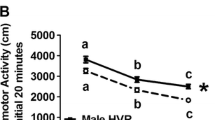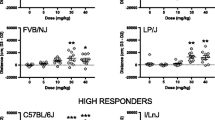Abstract
Repeated administration of cocaine to B6AF1/J mice increased their running response to 20 mg/kg cocaine as much as four-fold over the response to the first injection. After four daily injections, the extent of the increase was proportional to the dose of cocaine that was used for pretreatment. Sensitization persisted for as long as 2 months after the last injection of cocaine. Cocaine-pretreated mice did not show an increased running response to either morphine or d-amphetamine. The response to cocaine was increased two-fold by treatment with morphine, and three-fold by pretreatment with d-amphetamine. Pretreatment with either imipramine or reserpine did not produce sensitization to cocaine. There was no correlation between cocainesensitization and whole-brain catecholamine levels. There were marked differences in both the running response to cocaine and the extent of cocaine sensitization between the parental strains, C57B1/6J and A/J. Experiments with recombinant-inbred lines, derived from C57Bl/6By and BALB/cBy mice, suggest that the initial response to cocaine and the development of sensitization are controlled by different genetic determinants.
Similar content being viewed by others
References
Ansell, G. B., Beeson, M. F.: A rapid and sensitive procedure for the combined assay of noradrenaline, dopamine and serotonin in a single brain sample. Analyt. Biochem. 23, 196–206 (1968)
Bailey, D. W.: Recombinant inbred strains. Transplantation 11, 325–327 (1971)
Bralet, J., Lallemant, A. M.: Influence du traitment par la cocaine sur la synthèse et la libération de la noradrénaline cérébrale. Arch. int. Pharmacodyn. 217, 332–341 (1975)
Dengler, H. G., Spiegel, H. E., Titus, E. O.: Effect of drugs on uptake of nor-epinephrine by cat tissues. Nature (Lond.) 191, 816–817 (1961)
Down, A. W., Eddy, N. B.: The effect of repeated doses of cocaine on the rat. J. Pharmacol. exp. Ther. 46, 199–200 (1932)
Goldstein, A.: Biostatistics: An introductory text, p. 55. New York: Macmillan 1964
Hawks, R. L., Kopin, I. H., Colburn, R. W., Thoa, N. B.: Norcocaine: a pharmacologically active metabolic of cocaine found in brain. Life Sci. 15, 2189–2195 (1974)
Hertting, G., Axelrod, J., Whitby, L. G.: Effect of drugs on the uptake and metabolism of 3H-norepinephrine. J. Pharmacol. exp. Ther. 134, 146–153 (1961)
Iversen, S. D., Iversen, L. L.: Behavioral pharmacology. New York: Oxford University Press 1975
Jaffe, J. H.: Drug addiction and drug abuse. In: The pharmacological basis of therapeutics, L. S. Goodman and A. Gilman, eds., p. 304. New York: MacMillan 1975
Mason, P.: Drug dependence caused by non-narcotics. In: Animal and clinical pharmacologic techniques in drug evaluation, vol. 2, P. E. Siegler and J. H. Moyer III, eds., pp. 383–388 Chicago: Year Book Medical Publishers 1967
Nayak, P. K., Misra, A. L., Mulé, S. J.: Physiological disposition and biotransformation of (3H) cocaine in acute and chronically-treated rats. J. Pharmacol. exp. Ther. 196, 556–569 (1976)
Post, R. M., Kopanda, R. T.: Cocaine, kindling and reverse tolerance. Lancet 1975, 409–410
Post, R. M.: Cocaine psychoses: a continuum model. Amer. J. Psychiat. 132, 225–231 (1975)
Post, R. M.: Rose, H.: Increasing effects of repetitive cocaine administration in the rat. Nature (Lond.) 260, 731–732 (1976)
Seevers, M. H., Deneau, G. A.: Physiological aspects of tolerance and physical dependence. In: Physiological pharmacology, vol. 1, W. S. Root and E. G. Hofmann, eds., p. 629. New York: Academic Press 1963
Sharpless, S. K.: Supersensitivity-like phenomena in the central nervous system. Fed. Proc. 34, 1990–1997 (1975)
Short, P. H., Shuster, L.: Changes in brain norepinephrine associated with sensitization to d-amphetamine. Psychopharmacology 48, 59–67 (1976)
Shuster, L., Webster, G. W., Yu, G.: Increased running response to morphine in morphine-treated mice. J. Pharmacol. exp. Ther. 192, 64–72 (1975a)
Shuster, L., Webster, G. W., Yu, G.: Perinatal narcotic addiction in mice: sensitization to morphine stimulation. Addict. Dis 2, 277–292 (1975b)
Shuster, L., Webster, G. W., Yu, G., Eleftheriou, B. E.: A genetic analysis of the response to morphine in mice: Analgesia and running. Psychopharmacologia (Berl.) 42, 249–254 (1975c)
Smith, C. B.: Enhancement by reserpine and α-methyl dopa of the effects of d-amphetamine upon locomotor activity of mice. J. Pharmacol. exp. Ther. 142, 343–350 (1963)
Tatum, A. L., Seevers, M. H.: Experimental cocaine addiction. J. Pharmacol. exp. Ther. 36, 401–410 (1929)
Author information
Authors and Affiliations
Rights and permissions
About this article
Cite this article
Shuster, L., Yu, G. & Bates, A. Sensitization to cocaine stimulation in mice. Psychopharmacology 52, 185–190 (1977). https://doi.org/10.1007/BF00439108
Received:
Accepted:
Issue Date:
DOI: https://doi.org/10.1007/BF00439108




